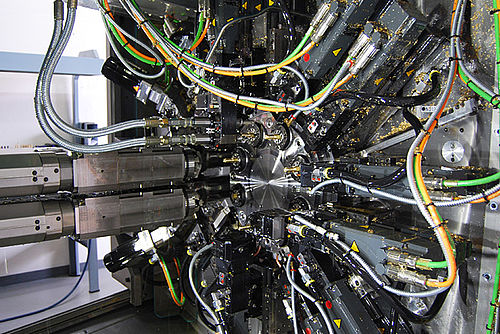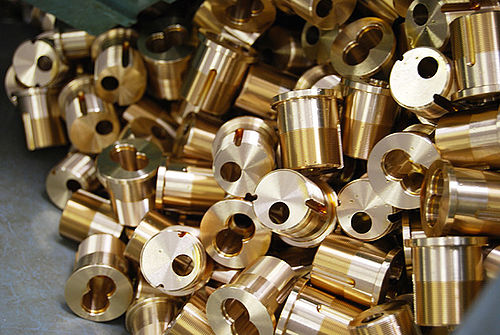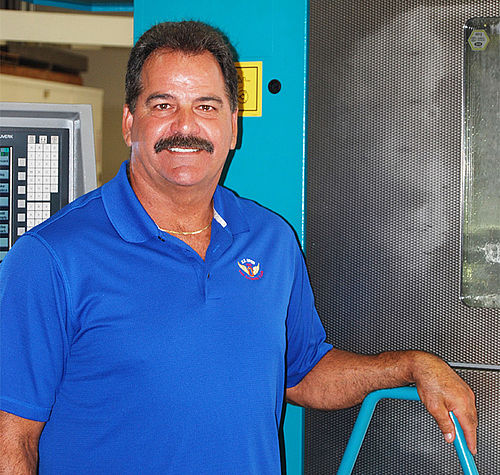Climbing the Ladder of Success with Multi-spindle CNCs
Constantly on the mind of most precision shop owners and managers is how to get and keep profitable work. Precision part manufacturing is a global business. Competitors can come from almost anywhere.
For Alan Hammond, President of Hammond Enterprises, Pittsburg, CA, it has been essential to keep climbing the ladder of technology, improving the company’s ability to make difficult parts more quickly, to higher levels of quality and at lower cost than other shops can.
Hammond Enterprises opened its doors in 1989. Hammond was a skilled machinist at Lockheed. “At the beginning we had a niche making medical devices for a few engineering companies. I continued making parts in our garage for a few years until the business grew into something that we felt could sustain itself. We had low expectations and simply wanted to make a living enjoying what we were doing.”
Word about the shop’s quality and problem-solving ability got around, however, and things started to change.
“Then we moved into a small commercial building with 1,200 square feet and bought our first twin-spindle turn-mill from Mazak. That plus a few Hurcos was all we had, and we thought we would never fill that space. We got busier and stayed for a few years. Then we were approached several times by a major global manufacturer that needed a reliable source for precision parts, but I told them I was not into production. I was more of an R&D guy.
“Finally, the guy came to us again. I was the only shop locally that had mill-turn operations. So we started making parts for them, just a few thousand a month at first. Then we moved to our current location, added more space, and went from about 5,000 parts a month to 85,000 parts a day.
“Then, to be competitive with China—that’s the big 600-lb gorilla—we got into even more complex parts. We are fortunate that we make parts they struggle with. We haven’t lost any parts to China in the last 10 years.”
Today, Hammond is a shop of more than 40 employees, running more than 400 different part numbers a year over 20 CNC machine tools, from Hurco mills to INDEX automatic turning machines.
“A typical job shop like us will try to achieve as much return as possible with minimal risk, so they end up processing a part pretty much the same way. The way Hammond is different is by having the technology to reduce the cost of a customer’s part, and helping them meet their goals. In this way, we can build ourselves into a strategic supplier,” Hammond said. “We have gotten there by investing in high-end machine tools. We offer a capability to our customers that they are reluctant to lose.
“As we saw the need to produce more complex, higher value parts, we got into INDEX G Series mill-turns and now have six of those. Then we got into smaller parts, so we bought TRAUB TNL Swiss turning machines. When we were running an extrusion part in very high volumes, we got into a rotary transfer machine by Hydro-Mat.”
As Hammond’s work expanded and volumes increase on the twin-spindle machines, there was always a need to make the parts faster.
“So then we bought two six-spindle CNC’s,” Hammond said. “We wanted to buy INDEX, but did not. And as I have learned, you don’t get into new technology unless the vendor is extremely capable in it. You’ve got to have attentive support from sales and applications people and critical parts off the shelf.”
How Multi-spindles Fit in at Hammond
Moving into multi-spindles was a well-considered strategic move at Hammond. “Our challenge to go to multi-spindle was if you have six twin spindles and one multi-spindle, the multi can beat them. That said, if the multi does not run, you make no parts. If one of the twin spindles goes down, you can at least make some parts.
“You need both capabilities to keep the flow going. When you do, you can be full-service, from R&D to low production to higher production. At the end of the day, the money is in the high production after the process is proven. And a key to keeping the production business is to reduce the cost per part while providing the quality production the customer needs. We found that multi-spindles are the way we do this.”
Hammond was not in a huge rush to buy a multi-spindle. “When I went to IMTS one year, I had no intention of buying anything. Zero anticipation of spending a dollar. My plant manager and I went to see what may be new, as I had not been to Chicago for several shows.
“I went to the INDEX booth and looked at the MS 22-8, an eight-spindle with double unloader, and I thought ‘Wow.’ I’ve had that reaction to other machines in the past, but my thought was not how to justify getting it. It was how do I justify not getting it. So I bought the thing. It’s been a dream machine. It runs every day with top reliability and excellent service and support. INDEX has been beautiful to work with.”
The modular eight-spindle MS22-8 offers Hammond additional opportunities for extremely fast multi-spindle parts machining, especially highly complex parts with applications from automotive to medical technology. It also produces small batches efficiently and economically, and can be bar-fed or loaded with chucked parts.
The INDEX MS22-8 can be configured to operate as an eight-spindle machine, a double four-spindle machine that drops two complete parts at a time, or as a machine with double rear-end machining. Highly versatile, it is capable of turning, off-center drilling and thread cutting, inclined and cross-drilling, milling, multi-edge turning, hobbing, tooth milling, deep-hole drilling or slotting.
At Hammond, the MS22C-8 in double four-spindle mode actually runs as two machines working with each other simultaneously on a single base. Every second tool station always has simultaneous access to the same tools.
Each of the eight spindles, arranged in the well-known INDEX spindle drum, are assigned two cross slides which can travel both on the X and Z axes. Each cross slide can be also equipped with a Y-axis. Up to two swiveling synchronous spindles permit simultaneous rear-end machining. With a total of up to 16 cross slides, the eight-spindle machine gives Hammond an edge for the highly complex machining its customers’ parts require.
“So our thinking for multis was that we could avoid the massive retooling cost if we had to make changes in the part. With the eight-spindle and double unloader, we would have versatility to make the same part on every other spindle. If we have six spindles and one unloader, you can only unload one part at a time. But with the double unloader, you can split production between, for example, spindles 1, 3, 5 and 7 making part A and the other spindles making another part from the same stock. About half our parts fit into the 22-mm capacity multi. Our next move would be into a 40-mm INDEX multi.”
One Step at a Time
An example of Hammond’s business-building strategy involving the productive capabilities of the multi-spindles shows how and why the company moved into the machines.
One of the parts Hammond produces is now in the million a year range. “We had started at a lower volume, moving in steps from the TRAUB to the multis. And the customer can’t move the job because we are making them so well, so fast and so cheaply, using the optimum level of technology through each step as part volumes increased,” Hammond said.
The versatility of the multi-spindle machines is vital to Hammond. While it may seem like a big jump to go from a typical twin-spindle lathe to a multi-spindle, a logical step up for the company was to move to an INDEX C200 automatic lathe and the TRAUBs. “The machines all feed into each other to help us develop the confidence to move up. As you become comfortable with the technology, you can stay on the ladder.”
When operated as an eight-spindle machine, the MS22-8’s drum indexing angle from spindle to spindle is 45°. If the machine operates with two times four spindles, the drum indexing angle is 90°. With double four-spindle machining, two finished parts are produced by the machine per work cycle.
Hammond continued, “The difference between the cam-type machines and this multi-spindle CNC is that, although we may not be able to make a part quite as fast as a dedicated cam machine, we can make two parts within the same cycle. So one machine tool is making two parts in every cycle instead of one, and it doesn’t have to be the same part.”
The speed of each of the eight spindles can be controlled separately. The liquid-cooled spindle drum keeps the thermal growth in the spindle carrier to a minimum, and the spindle bearing temperature can be kept at a low level, which also supports service life.
The cross slides with integrated drives have a low-mass design with hydrostatic bearing support. Their low moment of inertia and resulting high dynamics facilitate outstanding acceleration in operation, further reducing cycle time.
Reference a particular part, Hammond said, “On this part, previously, the cycle time was 82 seconds. It is now about 20 seconds, with the MS22-8 dropping two at a time. The machine is actually splitting the time, doing a lot of work on the back of the part, using all eight spindles to produce the complex part.
“The unloaders at station 7 and 8 know which part to unload as the spindle drum changes position to cycle around to present the part to the next station. This unloading capability alone saved us about 20% on cycle time. The two-part processing capability permits backworking, yet does not slow down the drum from rotating. I love what that technology does,” Hammond said.
After front machining, for which six spindle positions are available, workpieces are picked up by two rear machining units and machined simultaneously on the rear end.
Because rear-end machining is done during two drum indexing cycles, up to six tools can be used for this simultaneously with the other spindles. With all cross slides located at the same travel angle to one another, free chip flow is guaranteed in each position.
Cost is certainly a factor. “The jump-in cost from twin spindles to multis is about 4:1,” Hammond pointed out. “The biggest thing for me is that if you move forward and catch the next rung of technology, your operation will advance. On the other hand, if you do not catch the next rung, you can never catch up.
“We spend every year on new technology. If there is something out there that keeps us viable and in business—because these days there is only a fine line between what any two shops may do—then you need to look into it. You also must have confidence in your team to be able to adjust to the new technology. If not, you have immediately limited your potential. If you don’t keep up, you will be farther behind,” Hammond said.
“Our philosophy is that you are in business or you are going out of business. If you are in business, why would you not want this technology? You want to be the best in the business. And if you can find the machine that will run and be promptly serviced and supported, it helps eliminate the fear of a new investment. The payoff is that when you have a part that runs, you help yourself to the next stage.
“Most important to me, though, in buying technology is support, support, support. Don’t buy from a run-of-the-mill company. It’s what helps us get the cycle time that keeps us in business. You have to be able to rely on the promises of your vendor. I’m a big INDEX fan and have been buying them since 1996. They are very professional in what they do. We get the solid support we need to work out our time studies for a customer job. You don’t get that from a lot of machine tool companies.”





































